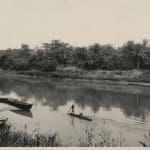[Cacao Harvesting]
Collection of Photos Showing Cultivation in Côte d'Ivoire, 1920s
Silver prints (35)
Most 9 1/2 x 7 inches, a few slightly smaller
Further images
These early 20th-century photographs show the harvesting and refinement of cocoa in Côte d’Ivoire. The images show workers in fields full of harvested cacao pods, or working under corrugated metal...
These early 20th-century photographs show the harvesting and refinement of cocoa in Côte d’Ivoire. The images show workers in fields full of harvested cacao pods, or working under corrugated metal roofs to crush and refine the beans. There are several beautiful images taken from the banks of a large body of water, including a bustling harbor packed with small boats.
Four of the photographs feature the same unidentified white man, shown always with pith helmet on. He was likely the French owner of the operation. When France seized control of Côte d’Ivoire in the 1880s, they prioritized the development of exports, including not just cocoa but coffee and bananas. Unlike most other French colonies, where the majority of the French residents were bureaucrats, Côte d’Ivoire was home to a large contingent of French settlers, who owned roughly one-third of the plantations in the country.
Though native to the Amazon rainforest, cocoa beans are today grown in warm, tropical environments the world over. The Spanish brought the bean back to Europe, where chocolate proved to be a sensation. Colonialism saw it spread across Africa and Asia. Today, over 70% of the world’s cocoa is grown in West Africa, with Côte d’Ivoire and Ghana responsible for the majority of the world’s production.
Four of the photographs feature the same unidentified white man, shown always with pith helmet on. He was likely the French owner of the operation. When France seized control of Côte d’Ivoire in the 1880s, they prioritized the development of exports, including not just cocoa but coffee and bananas. Unlike most other French colonies, where the majority of the French residents were bureaucrats, Côte d’Ivoire was home to a large contingent of French settlers, who owned roughly one-third of the plantations in the country.
Though native to the Amazon rainforest, cocoa beans are today grown in warm, tropical environments the world over. The Spanish brought the bean back to Europe, where chocolate proved to be a sensation. Colonialism saw it spread across Africa and Asia. Today, over 70% of the world’s cocoa is grown in West Africa, with Côte d’Ivoire and Ghana responsible for the majority of the world’s production.
![[Cacao Harvesting], Collection of Photos Showing Cultivation in Côte d'Ivoire, 1920s](https://artlogic-res.cloudinary.com/w_1600,h_1600,c_limit,f_auto,fl_lossy,q_auto/artlogicstorage/dollc/images/view/893ade959b2d7764b5129c28163987faj/daniel-oliver-cacao-harvesting-collection-of-photos-showing-cultivation-in-c-te-d-ivoire-1920s.jpg)
![[Cacao Harvesting], Collection of Photos Showing Cultivation in Côte d'Ivoire, 1920s](https://artlogic-res.cloudinary.com/w_1600,h_1600,c_limit,f_auto,fl_lossy,q_auto/artlogicstorage/dollc/images/view/a85be976bd60f2b2811cb36b18abaea0j/daniel-oliver-cacao-harvesting-collection-of-photos-showing-cultivation-in-c-te-d-ivoire-1920s.jpg)
![[Cacao Harvesting], Collection of Photos Showing Cultivation in Côte d'Ivoire, 1920s](https://artlogic-res.cloudinary.com/w_1600,h_1600,c_limit,f_auto,fl_lossy,q_auto/artlogicstorage/dollc/images/view/eab843953181074b87f39295e1588e36j/daniel-oliver-cacao-harvesting-collection-of-photos-showing-cultivation-in-c-te-d-ivoire-1920s.jpg)
![[Cacao Harvesting], Collection of Photos Showing Cultivation in Côte d'Ivoire, 1920s](https://artlogic-res.cloudinary.com/w_1600,h_1600,c_limit,f_auto,fl_lossy,q_auto/artlogicstorage/dollc/images/view/ade23c6669cf8aabfcc2582337fb82d4j/daniel-oliver-cacao-harvesting-collection-of-photos-showing-cultivation-in-c-te-d-ivoire-1920s.jpg)
![[Cacao Harvesting], Collection of Photos Showing Cultivation in Côte d'Ivoire, 1920s](https://artlogic-res.cloudinary.com/w_1600,h_1600,c_limit,f_auto,fl_lossy,q_auto/artlogicstorage/dollc/images/view/b1da008d27a9126306e89403c9ec62fcj/daniel-oliver-cacao-harvesting-collection-of-photos-showing-cultivation-in-c-te-d-ivoire-1920s.jpg)
![[Cacao Harvesting], Collection of Photos Showing Cultivation in Côte d'Ivoire, 1920s](https://artlogic-res.cloudinary.com/w_1600,h_1600,c_limit,f_auto,fl_lossy,q_auto/artlogicstorage/dollc/images/view/a00cd9f51132b1a460bf7c144f0ec7ecj/daniel-oliver-cacao-harvesting-collection-of-photos-showing-cultivation-in-c-te-d-ivoire-1920s.jpg)
![[Cacao Harvesting], Collection of Photos Showing Cultivation in Côte d'Ivoire, 1920s](https://artlogic-res.cloudinary.com/w_1600,h_1600,c_limit,f_auto,fl_lossy,q_auto/artlogicstorage/dollc/images/view/0ce4b460934a7b442195d22e916255c5j/daniel-oliver-cacao-harvesting-collection-of-photos-showing-cultivation-in-c-te-d-ivoire-1920s.jpg)






